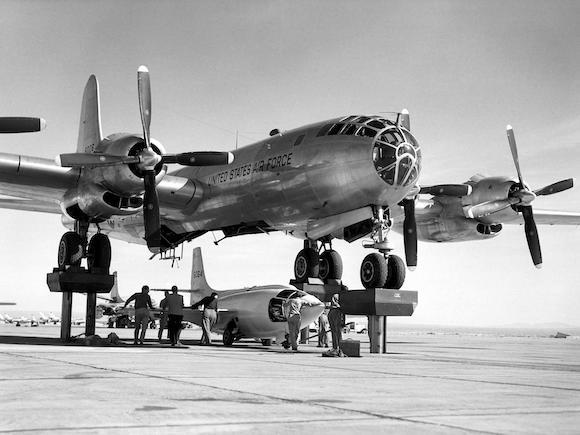XS-1 Supersonic Scoop (1947)

Aviation Week scored one of the biggest aerospace scoops of the 20th century when on December 22, 1947, it revealed that the fabled sound barrier had been broken by U.S. Air Force Capt. Charles ‘Chuck’ Yeager in the Bell XS-1.

Capt. Charles ‘Chuck’ Yeager achieved Mach 1.06 on his record flight in Bell X-1 No.1 46-062, pictured here under power from its Reaction Motors XLR11 rocket engine.
The news was leaked to the magazine’s renowned and respected Engineering Editor Robert McLarren around two months after the October 14 flight over Muroc Dry Lake, California, and made instant headlines around the world. At the time, the pursuit of high speed flight in excess of the speed of sound had become a serious technical challenge for the early jet designers. Teams across America, Britain and France were racing to be the first to push a manned aircraft beyond Mach 1.
The mysterious and intriguingly named ‘sound barrier’, so-called because of the effects of compressibility encountered by aircraft in the transonic speed region, also captured the imagination of the post-World War Two public. The sensation caused by Aviation Week’s story, not to mention the disclosure of classified test results, therefore infuriated the Air Force. According to Jay Miller, writing in his authoritative ‘X-Planes’ history, the Aviation Week story “caught the Air Force completely by surprise. Rumors of legal action, based on what the Air Force considered a very serious security breach, against Aviation Week persisted for weeks, but nothing came of them. The flight now was public domain and a lawsuit could not suppress the fact.”

Similar to the B-29 used for initial X-1 flights, the more powerful EB-50A derivative was selected as a carrier aircraft for later tests. Here the ill-fated third X-1 is seen being readied for loading beneath the aircraft in 1951. Both the X-1 and B-50 were destroyed by fire in November that year when liquid oxygen reacted with Ulmer leather gaskets in the experimental aircraft.
Described by McLarren as the Bell XS-1 (‘S’ for supersonic, a title later simplified to X-1), the aircraft fuselage configuration closely resembled a .50 caliber bullet, the theory being that this was known to be a stable aerodynamic shape at sonic velocity. The rocket-powered vehicle also had straight, thin, but strong wings which McLarren identified as a significant factor given that swept wings were fast becoming the favored configuration for higher speed designs. “Now the possibility exists that swept wings will not be required for supersonic aircraft and a re-evaluation of high speed design characteristics of current projects is indicated.”
Given the pioneering times we can forgive McLarren for such speculation, particularly when he was working on such relatively limited information. It's also curious to see in the story that Yeager’s name is misspelled Yaeger. Was this a simple error, or perhaps deliberately done as part of efforts to protect his source? We shall never know, but regardless of this, McLarren’s supersonic scoop remains one of Aviation Week’s greatest breaking news stories.
Read the December 22, 1947 edition cover story: Bell XS-1 Makes Supersonic Flight
This blog was originally published on February 23, 2016.